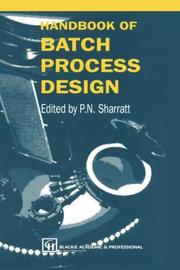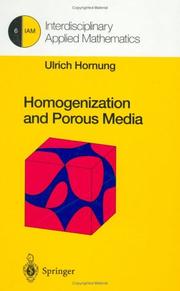| Listing 1 - 8 of 8 |
Sort by
|

ISBN: 1281077232 9786611077235 0080536581 9780080536583 9780750637602 0750637609 0750637609 9781281077233 6611077235 Year: 1997 Publisher: Oxford Boston Butterworth-Heinemann
Abstract | Keywords | Export | Availability | Bookmark
 Loading...
Loading...Choose an application
- Reference Manager
- EndNote
- RefWorks (Direct export to RefWorks)
This volume is a valuable reference work for the student and the practising engineer in the chemical, pharmaceutical, minerals, food, plastics, paper and metallurgical industries.The second edition of this successful text has been thoroughly rewritten and updated. Based on the long running post-experience course produced by the University of Bradford, in association with the Institution of Chemical Engineers, it covers all aspects of mixing, from fundamentals through to design procedures in single and multi-phase systems. Experts from both industry and academia have contributed to th
Mixing. --- Mixing --- Chemical & Materials Engineering --- Engineering & Applied Sciences --- Chemical Engineering --- Mixing machinery. --- Agitators (Machinery) --- Kneading machinery --- Mixers (Machinery) --- Stirrers (Machinery) --- Blending --- Machinery --- Chemical engineering --- Fluid dynamics --- Hydrodynamics --- Agrotechnology and Food Sciences. Food and Bioprocess Engineering --- Physical Operations --- Mechanical Operations.
Book
Year: 1997 Publisher: Cleveland, Ohio : National Aeronautics and Space Administration, Lewis Research Center,
Abstract | Keywords | Export | Availability | Bookmark
 Loading...
Loading...Choose an application
- Reference Manager
- EndNote
- RefWorks (Direct export to RefWorks)
Aeroacoustics. --- Acoustic properties. --- Aerodynamic noise. --- Jet aircraft noise. --- Jet mixing flow. --- Noise measurement. --- Mixers.

ISBN: 0471961620 Year: 1997 Publisher: Chichester Wiley
Abstract | Keywords | Export | Availability | Bookmark
 Loading...
Loading...Choose an application
- Reference Manager
- EndNote
- RefWorks (Direct export to RefWorks)
Dispersion --- Estuarine oceanography --- Oceanic mixing --- 574.5 --- 532.5 --- Mixing, Oceanic --- Ocean circulation --- Oceanography --- Optics --- Hydrobiology. Aquatic biocoenoses and ecosystems. Food chains --- Liquid motion. Hydrodynamics --- Dispersion. --- Estuarine oceanography. --- Oceanic mixing. --- 532.5 Liquid motion. Hydrodynamics --- 574.5 Hydrobiology. Aquatic biocoenoses and ecosystems. Food chains
Article
Abstract | Keywords | Export | Availability | Bookmark
 Loading...
Loading...Choose an application
- Reference Manager
- EndNote
- RefWorks (Direct export to RefWorks)
Many studies have been carried out with the aim of reducing aggression after mixing unfamiliar pigs. A major problem in these studies has been the individual variation in aggressiveness between pigs. This study examined whether aggressiveness, as measured in tests on individual animals in a resident-intruder situation, is predictive of the level of aggression shown after mixing unfamiliar pigs, and whether information on this individual aggressiveness can be used to reduce aggression after mixing. One hundred eighty-nine pigs were tested for individual aggressiveness in their home pens and categorised as high- or low-aggressive (H or L), according to their attack latency. Eighty-eight of these pigs were then mixed in groups of eight, with four pigs from each of two litters. The combinations used were H/H (4H + 4H), H/L (4H + 4L) and L/L (4L + 4L). In a follow-up study, a further 32 pigs were mixed into the combinations HL/HL (HHLL + HHLL). The pigs were observed for 3 h on the day of mixing, and for 2 h on days 1, 2, 6 and 7 after mixing. During observations, aggressive interactions, and whether the pigs avoided lying down next to a pig from the unfamiliar litter were recorded. Fresh skin lesions were counted on each pig 2 h following mixing, and again 2 days later. In the majority of the groups, there was a clear distinction between a winner- and a loser-litter within the first 2 h after mixing. The number of pairs fighting in the 2 h immediately following mixing was lowest in the H/L groups. The number of skin lesions on the pigs from the winner-litter both immediately after mixing and 2 days later was highest in H/H groups. Thus, the relative level of aggressiveness seemed to determine the number of pairs that fought and the absolute level determined the intensity of fighting, with L pigs fighting less vigorously than H pigs. Speed of group integration was again affected by the absolute level of aggressiveness. The presence of H pigs in a group slowed down gro
Aggression. --- Aggressive. --- Aggressiveness. --- Animal. --- Animals. --- Fighting. --- Group. --- Individual variation. --- Interaction. --- Interactions. --- Lesion. --- Lesions. --- Level. --- Lying down. --- Lying. --- Mixing. --- Observation. --- Pen. --- Pig. --- Pigs. --- Test. --- Tests. --- Variation.
Book
ISBN: 9810231652 Year: 1997 Publisher: Singapore : World Scientific Publishing Co,
Abstract | Keywords | Export | Availability | Bookmark
 Loading...
Loading...Choose an application
- Reference Manager
- EndNote
- RefWorks (Direct export to RefWorks)
Chemical engineering. --- Fractals. --- Mixing. --- Adsorption --- Aggregates --- Chaos (dynamical) --- Disorder --- Reactors --- Transport properties --- Turbulence --- Aggregates --- Chaos (dynamical) --- Disorder --- Reactors --- Transport properties --- Turbulence
Article
Abstract | Keywords | Export | Availability | Bookmark
 Loading...
Loading...Choose an application
- Reference Manager
- EndNote
- RefWorks (Direct export to RefWorks)
Studies concerning aggression after mixing unfamiliar pigs have shown that there is a great variability in the levels of aggression shown by individual pigs. This study examined whether individual aggressiveness can be measured in a resident-intruder situation and whether it is a stable characteristic of individuals, which does not simply reflect the age or sex class of the animal. These latter requirements are of fundamental importance in establishing the existence of individual personality or temperament characteristics in animals. The research was carried out in three datasets, with a total of 218 pigs, females and entire males, at the age of 7 and 11 weeks. For the test, individual pigs were isolated in one half of their home pen, and an intruder pig was introduced. This pig was 2-3 weeks younger than the resident pig. The time from when the resident first made contact to when it attacked the intruder pig was used as a measure of aggressiveness. If the resident did not attack, the test was terminated after 3.5 min. The test was repeatable across two consecutive days as well as across four weeks. Aggressiveness was found to be unrelated to characteristics of the test pigs, such as sex, age, body weight and body weight ranked within litter. Attack latency was not affected by the sex of the intruder pig. If the intruder was less than half the body weight of the test pig, it was less likely to be attacked. Considerable variation was found within as well as between litters. The importance of the nature of the test arena, and implications of the duration of the test are discussed. Using attack latency as a measure of aggressiveness and a relatively short time limit, the test provides a useful tool for measuring aggressiveness without compromising the welfare of the animals involved
Age. --- Aggression. --- Aggressiveness. --- Animal. --- Animals. --- Body weight. --- Body-weight. --- Contact. --- Duration. --- Female. --- Females. --- Growing pigs. --- Growing-pigs. --- Intruder. --- Level. --- Male. --- Males. --- Mixing. --- Pen. --- Personality. --- Pig. --- Pigs. --- Research. --- Sex. --- Sexes. --- Temperament. --- Test. --- Time. --- Tool. --- Variability. --- Variation. --- Weight. --- Welfare.

ISBN: 0751403695 Year: 1997 Publisher: Blackie,
Abstract | Keywords | Export | Availability | Bookmark
 Loading...
Loading...Choose an application
- Reference Manager
- EndNote
- RefWorks (Direct export to RefWorks)
Environmental policy. --- Mixing. --- Agitation (mechanical) --- Chemical engineering design --- Filtration --- Fire --- Physicochemical simulation --- Process control --- Solvents --- Unit process --- Agitation (mechanical) --- Chemical engineering design --- Filtration --- Fire --- Physicochemical simulation --- Process control --- Solvents --- Unit process

ISBN: 0387947868 1461273390 1461219205 Year: 1997 Publisher: New York (N.Y.): Springer
Abstract | Keywords | Export | Availability | Bookmark
 Loading...
Loading...Choose an application
- Reference Manager
- EndNote
- RefWorks (Direct export to RefWorks)
66.063 --- 62-405.8 --- Mixing of liquids. Dilution. Homogenization --- Porous. Cellular. Sponge-like --- Fluid dynamics. --- Homogenization (Differential equations) --- Porous materials --- Environmental Sciences and Forestry. Water Management --- Basic Sciences. Mathematics --- Mathematical models. --- Geohydrology, Soil Hydrology --- Mathematical Models, Simulation Models --- 66.063 Mixing of liquids. Dilution. Homogenization --- 62-405.8 Porous. Cellular. Sponge-like --- Homogenization (Differential equations). --- Geohydrology, Soil Hydrology. --- Mathematical Models, Simulation Models. --- Fluid dynamics --- Porous media --- Materials --- Porosity --- Differential equations, Partial --- Dynamics --- Fluid mechanics --- Mathematical models --- Mathematical analysis. --- Analysis (Mathematics). --- Mathematical physics. --- Analysis. --- Theoretical, Mathematical and Computational Physics. --- Physical mathematics --- Physics --- 517.1 Mathematical analysis --- Mathematical analysis --- Mathematics
| Listing 1 - 8 of 8 |
Sort by
|

 Search
Search Feedback
Feedback About UniCat
About UniCat  Help
Help News
News